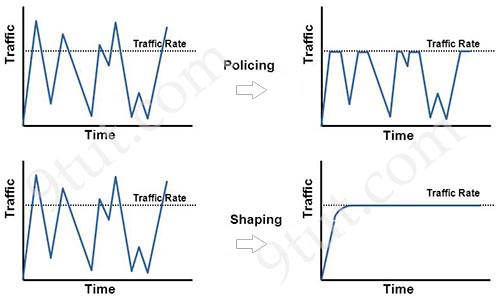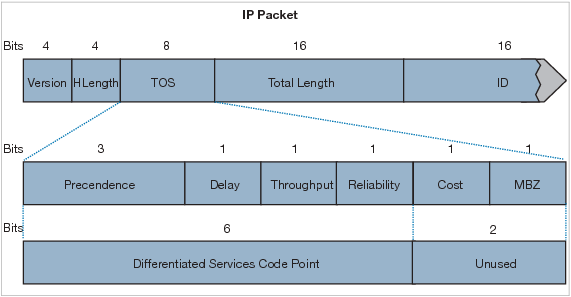QoS Questions
|
QoS quick summary: 1. Network factors: 2. QoS Models: 3. QoS Markings: 4. QoS terms:
5. Congestion Management (types of queuing): uses the marking on each packet to determine which queue to place packets in |
Question 1
Explanation
The following diagram illustrates the key difference between traffic policing and traffic shaping. Traffic policing propagates bursts. When the traffic rate reaches the configured maximum rate (or committed information rate), excess traffic is dropped (or remarked). The result is an output rate that appears as a saw-tooth with crests and troughs. In contrast to policing, traffic shaping retains excess packets in a queue and then schedules the excess for later transmission over increments of time. The result of traffic shaping is a smoothed packet output rate.

Note: Committed information rate (CIR): The minimum guaranteed data transfer rate agreed to by the routing device.
Question 2
Question 3
Explanation
The IP datagram header contains an 8-bit field called ToS (Type of Service). The field has been part of the IP header since the beginning, but it was rarely used until the recent introduction of Differentiated Services (Diff-Serv).

Note:
+ CoS does not exists in an IP header. It appears in the header of a 802.1Q frame only. CoS is used for QoS on a trunk link.
+ DSCP uses the first 6 bits of the TOS field.
Question 4
Explanation
The Resource Reservation Protocol (RSVP) protocol allows applications to reserve bandwidth for their data flows. It is used by a host, on the behalf of an application data flow, to request a specific amount of bandwidth from the network. RSVP is also used by the routers to forward bandwidth reservation requests.
Question 5
Explanation
The following diagram illustrates the key difference between traffic policing and traffic shaping. Traffic policing propagates bursts. When the traffic rate reaches the configured maximum rate (or committed information rate), excess traffic is dropped (or remarked). The result is an output rate that appears as a saw-tooth with crests and troughs. In contrast to policing, traffic shaping retains excess packets in a queue and then schedules the excess for later transmission over increments of time. The result of traffic shaping is a smoothed packet output rate.

Note: Committed information rate (CIR): The minimum guaranteed data transfer rate agreed to by the routing device.
Question 6
Explanation
Layer-3 marking is accomplished using the 8-bit Type of Service (ToS) field, part of the IP header. A mark in this field will remain unchanged as it travels from hop-to-hop, unless a Layer-3 device is explicitly configured to overwrite this field. There are two marking methods that use the ToS field:
+ IP Precedence: uses the first three bits of the ToS field.
+ Differentiated Service Code Point (DSCP): uses the first six bits of the ToS field. When using DSCP, the ToS field is often referred to as the Differentiated Services (DS) field.

Reference: http://www.routeralley.com/guides/qos_classification.pdf
Question 7
Explanation
The following diagram illustrates the key difference between traffic policing and traffic shaping. Traffic policing propagates bursts. When the traffic rate reaches the configured maximum rate (or committed information rate), excess traffic is dropped (or remarked). The result is an output rate that appears as a saw-tooth with crests and troughs. In contrast to policing, traffic shaping retains excess packets in a queue and then schedules the excess for later transmission over increments of time. The result of traffic shaping is a smoothed packet output rate.

Question 8
Question 9
Explanation
With Priority Queueing (PQ), traffic is classified into high, medium, normal, and low priority queues. The high priority traffic is serviced first, then medium priority traffic, followed by normal and low priority traffic. -> Therefore we can assign higher priority for voice traffic.
Also with PQ, higher priority traffic can starve the lower priority queues of bandwidth. No bandwidth guarantees are possible -> It is still good because this network is mostly used for data traffic so voice traffic amount is small.
With First In First Out (FIFO) or Weighted Fair Queueing (WFQ), there is no priority servicing so they are not suitable here.
Reference: https://www.cisco.com/c/en/us/td/docs/ios/solutions_docs/qos_solutions/QoSVoIP/QoSVoIP.html
Weighted Random Early Detection (WRED) is just a congestion avoidance mechanism. WRED measures the size of the queues depending on the Precedence value and starts dropping packets when the queue is between the minimum threshold and the maximum threshold -> It does not have priority servicing either.
Question 10
Explanation
This module discusses the types of queueing and queueing-related features (such as bandwidth management) which constitute the congestion management QoS features:
Class-based WFQ (CBWFQ): extends the standard WFQ functionality to provide support for user-defined traffic classes. For CBWFQ, you define traffic classes based on match criteria including protocols, access control lists (ACLs), and input interfaces. Packets satisfying the match criteria for a class constitute the traffic for that class.
Priority queueing (PQ): With PQ, packets belonging to one priority class of traffic are sent before all lower priority traffic to ensure timely delivery of those packets.
Note: Committed Access Rate (CAR) is only used for bandwidth limitation by dropping excessive traffic.
Question 11
Explanation
The following diagram illustrates the key difference between traffic policing and traffic shaping. Traffic policing propagates bursts. When the traffic rate reaches the configured maximum rate (or committed information rate), excess traffic is dropped (or remarked). The result is an output rate that appears as a saw-tooth with crests and troughs. In contrast to policing, traffic shaping retains excess packets in a queue and then schedules the excess for later transmission over increments of time. The result of traffic shaping is a smoothed packet output rate.



